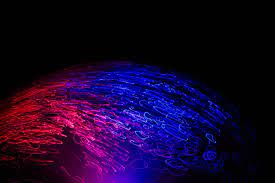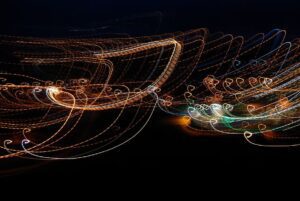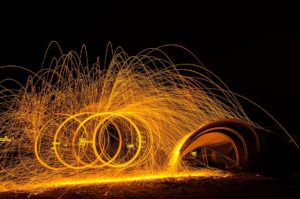In the realm of art, light and space aren’t just elements; they’re transformative forces that redefine our perception.
They’re tools artists wield to sculpt air and influence how we feel within a given environment.
We’ll explore how these intangible mediums became central to a movement that pushes the boundaries of visual experience.
Get ready to see art in a whole new light as we jump into the fascinating interplay of illumination and void.
Exploring Light And Space In Art
Light and space in art aren’t confined to the canvases hung in galleries; they extend to the vast, immersive installations we encounter in large-scale exhibitions.
Artists within this genre manipulate both elements to not only alter perceptions but also to create experiences that resonate on a deeper, often emotional level.
As experts fascinated by the way artistic expression evolves, light and space become a canvas of limitless potential.
In The Weather Project by Olafur Eliasson, visitors stepped into a simulation of the sun set against a mirrored ceiling, prompting a profound sense of contemplation.
The vast installation underlines how such works challenge the observer’s sense of reality.
These installations compel us to consider the importance of context – the environment itself becomes a part of the artwork, influencing how we engage with it.
The cinematic parallels are just as impactful.
In movies like Interstellar, light and space are used not just for visual effects but as key narrative devices.
The film integrates theoretical physics and the concept of the fourth dimension, taking viewers on a journey that stretches the imagination.
Some pioneering artists and films that have utilized light and space effectively include:
- James Turrell – renowned for his work with light as a medium,
- Robert Irwin – whose installations transform spatial perception,
- 2001: A Space Odyssey – which uses light and space to emphasize the vastness of the cosmos.
These instances highlight the boundless ways light and space transcend traditional visual methods to craft new modes of expression.
We’re intrigued by the possibilities this offers filmmakers and artists in creating sensory worlds that draw audiences beyond the superficial, inviting a unique interpretation and intimate dialogue with the work.
Technologically, our advancements have ushered in dynamic tools.
LED lighting, digital projection, and CGI empower creators to shape experiences that were once impossible.
It’s this synergy between innovation and artistic vision that continues to redefine our understanding of what art is and what it can be.
The Transformative Power Of Light And Space
The interplay of light and space within art can transform an ordinary room into an extraordinary sensory experience.
Masters of light and space art, such as James Turrell and Robert Irwin, have shown how altering these elements can fundamentally change the way we perceive and interact with our environment.

These artists’ works often require us to reconsider our relationship with the physical world.
Their installations can evoke feelings of disorientation, contemplation, or profound tranquility, moving beyond visual aesthetics to tap into deeper cognitive and emotional responses.
Exploring light and space in film, directors harness cinematography to push the boundaries of narrative and perspective.
In The Revenant, natural lighting not only sets the tone but also shapes the viewer’s emotional journey, enhancing the storytelling through the authentic representation of the landscape.
Filmmakers rely on these elements to craft scenes, guide emotions, and create visual metaphors.
Consider the following techniques:
- Manipulation of shadows to convey tension or mystery,
- Utilization of wide, open spaces to suggest freedom or isolation,
- Strategic placement of light sources to highlight characters or moments of significance.
Technological innovations in filmmaking have expanded the tools available to directors and cinematographers, empowering them to create more immersive and visceral experiences.
Films like Gravity Use a combination of lighting, spatial design, and cutting-edge effects to immerse the audience in the vastness of space, offering a depiction that’s as close to reality as possible without leaving Earth.
Within the realms of light and space art, it’s evident that our understanding of the physical world is malleable.
As artists and filmmakers continue to explore this domain, we witness a shift in how stories are told and experiences are crafted, affirming the inexhaustible potential of these pivotal elements in art.

The Connection Between Light And Space In Visual Perception
Visual perception is a dance between light and space, both shaping how we experience our surroundings.
Through carefully balanced interplay, artists like James Turrell demonstrate that light is not simply a tool to illuminate space – it’s an integral component of spatial perception.
Rather than serving as a backdrop, light can actively sculpt space, creating environments that challenge or reinforce our understanding of depth and boundaries.
Our visual perception relies on light to interpret the world around us.
In the realm of filmmaking, for instance, light guides the viewer’s attention and can dramatically alter the mood of a scene.
Renowned cinematographers harness light and shadow to convey subtle shifts in emotion or to highlight spatial dynamics:
- Establishing focus – using light to direct viewer’s gaze,
- Enhancing depth – manipulating lighting to add dimensionality to shots,
- Creating contrast – employing shadows to define and separate elements within a frame.
also, spatial configuration in filmmaking is not merely a static setting for action to unfold.
Much like in installations by artists such as Robert Irwin, space interacts with light to form a dynamic synthesis.
This combination propels narrative forward and engages audiences more deeply than traditional, static scenes might.
Filmmakers and artists alike understand that light and space are not passive entities but active participants in the storytelling process.
Understanding The Role Of Light And Space In Artistic Expression
Light and space are the pillars of visual storytelling, holding the power to transform a scene from ordinary to extraordinary.
Their interplay within artwork not only defines the physical parameters but also the emotional tenor of a piece.
By manipulating these elements, artists and filmmakers invite viewers to explore realms beyond the tactile world, often conjuring a more profound connection with the subject matter.
In the realm of light and space as artistic mediums, certain principles remain foundational.
First and foremost, light directs the viewer’s attention – it’s a spotlight on what’s crucial within the frame.
Conversely, space dictates the context and scale, establishing where that spotlight falls within the larger scene.
Here’s a glimpse at the dynamic duo’s role in artistic expression:
- Illumination and Shadow – Directing focus and adding depth.
- Color Temperature and Contrast – Influencing mood and viewer’s emotion.
- Perspective and Composition – Guiding the narrative without words.
Technological breakthroughs serve as a boon to artists and filmmakers by providing an expanded toolkit.
With these innovations, they’re able to create environments that defy traditional expectations.
Chiaroscuro in classical paintings, for instance, employs stark contrasts to achieve a dramatic effect, while in modern films like Inception, the bending of space within a scene challenges viewer perceptions, stirring curiosity and engagement.
Art installations such as those by Yayoi Kusama harness the vastness of space and the intensity of light, enveloping visitors in a cosmos of infinite reflections.
This sensory immersion alters one’s sense of place and reality – an experience that’s central to the creation of compelling, story-driven content in both galleries and cinema.
At its core, the use of light and space in artistic expression is about crafting visuals that elicit a visceral response.
It’s an intricate dance that, when done skillfully, speaks to the universal quest for meaning within the human experience.
Whether it’s through the lens of a camera or the brushstrokes on a canvas, mastering these elements is crucial to articulating a clear vision that resonates with audiences.
Pushing Boundaries: Light And Space As A Central Movement In Art
The Light and Space movement, originating in the 1960s Southern California, marked a radical departure from traditional art forms.
Pioneering artists like James Turrell and Robert Irwin embraced a minimalist approach, transforming galleries into otherworldly destinations.
They weren’t just painting the canvas; they were shaping the very environment around us.
Our mesmerized responses to their works demonstrate the potency of this artistic Try.
By playing with perception, these artists lead us into a deep exploration of our sensory experiences.

The crisp lines, the manipulation of natural and artificial light, and the serene ambience beckon viewers into a realm of pure contemplation.
- Artists at the movement’s forefront – * James Turrell * Robert Irwin * Doug Wheeler These visionaries extend their practice beyond the confines of the gallery space. Installations like Turrell’s Skyspace series invite us to gaze at the sky through an aperture, altering our perception of the heavens above. Irwin’s site-conditioned works seamlessly blend art with architecture, urging us to question the boundaries between the two.
In film, Light and Space principles have been adapted to stunning effect on screen.
The careful orchestration of illumination and setting in movies transforms mere backdrops into integral narrative elements.
This technique is not just about creating mood or supporting a story thread; it’s an active participant in the storytelling, shaping our emotional journey as we traverse the director’s carefully crafted landscapes.
As we jump into the intricacies of the Light and Space movement, we’re reminded of art’s enduring capacity to innovate and inspire.
In every precise alteration of shadow and every deliberate expansion of the physical space, we find a silent yet compelling invitation to see the world anew, free of conventional limitations.
The journey through light and space becomes a boundless exploration of our relationship with the environment and the myriad ways it can be perceived and experienced.
What Is Light And Space In Art – Wrap Up
We’ve delved into the captivating realm of light and space in art, a domain where minimalism intersects with profound sensory experiences.
It’s clear that the innovative spirit of artists like Turrell and Irwin continues to influence aesthetics and challenge our perceptions.
As we encounter these transformative works, we’re reminded of art’s unique power to reshape how we engage with the world around us.
Let’s carry this appreciation forward, allowing the lessons of light and space to illuminate our own creative journeys.
Frequently Asked Questions
What Is The Light And Space Movement?
The Light and Space movement is an art movement that originated in Southern California in the 1960s, known for its minimalist approach that integrates light and space to create immersive sensory experiences.
Who Are Key Artists Associated With The Light And Space Movement?
James Turrell and Robert Irwin are key artists associated with the Light and Space movement; they are noted for transforming galleries into transcendent spaces and manipulating perception with light.
How Does The Light And Space Movement Affect Viewers?
The Light and Space movement affects viewers by altering perception and creating deep, contemplative experiences, encouraging a profound engagement with the sensory elements of the art.
Has The Light And Space Movement Influenced Other Mediums?
Yes, the principles of the Light and Space movement have been adapted in film to create stunning visual effects, influencing the way movies are visually constructed and experienced.
Why Is The Light And Space Movement Important In Art History?
The Light and Space movement is important in art history for its pioneering approach to the use of light and architectural space, signifying a shift towards experiential, perception-based art.


